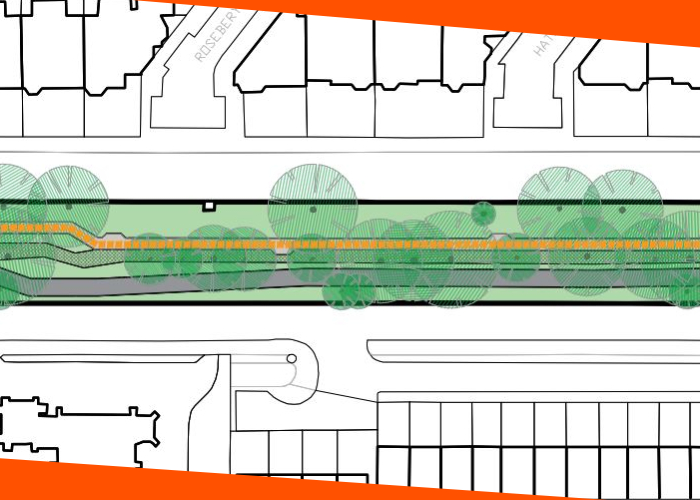
Princes Boulevard Artwork
The original Princes Boulevard STEP scheme suggested various opportunities for the local community to create a sense of place by incorporating a series of public artworks across the whole of the boulevard. Further artwork opportunities were identified through a series of community workshops and engagement resulting in a plethora of ideas around the agreed themes of history, culture, activism and the future. This led to the artworks you see on the Boulevard today…
The map can be viewed in full as a PDF Document here: STEP Scheme – Princes Boulevard Artwork Plan
The Princes Avenue Trail can be viewed in full as a PDF Document here: Friends Of Princes Avenue Trail
Present Artwork – STEP Scheme
| 1. | Interpretation Panels | |||
| 1.a. | Huskisson Plinth | |||
| The Huskisson plinth, which once celebrated the Victorian MP William Huskisson. It has been empty since 1982. The reasons for this have been acknowledged with a new inscription acknowledging his support of the slave trade. | ||||
| 1.b. | Faiths | |||
| Princes Boulevard is at the centre of a vibrant multi-faith community where people of different national origins, religions and spiritual beliefs have lived together since the mid-Nineteenth Century. The many places of worship both on and surrounding the Boulevard reflect the historic and continued cultural diversity of this Victorian thoroughfare. These are highlighted on the interpretation panel. | ||||
| 1.c. | ‘L8’ Sculpture | |||
| The much-loved ‘8’ sculpture has been given an enhanced setting with an accompanying ‘L’ and other sculptural pieces, telling the story of the journeys of the communities in settling in the L8 area. The sculpture is a reflection on the maritime heritage of the local community, which was shaped by merchant seafarers from across the globe. | ||||
| 1.d. | Activism | |||
| Liverpool 8, the traditional home of the city’s black and racial minority communities for over 100 years, has a long and proud history of political activism, resisting social injustice from the local to the global. Several organisations including The L8 Law Centre, Liverpool Black Sisters, Merseyside Immigration Advice Unit (MIAU) and the Elimu Study School were all housed on Princes Boulevard, and evolved from a long involvement in the area in the struggle for racial equality by Liverpool’s black communities. | ||||
| 1.e. | Night Clubs | |||
| Princes Boulevard and its surrounding streets have a long and vibrant black music and entertainment tradition, with sounds travelling across the Atlantic from other port cities. There were over forty clubs, including the Nigerian Club, within a two-mile radius, established largely by migrant seafarers who had settled in Liverpool and their partners. | ||||
| 1.f. | History | |||
| Princes Boulevard is a unique example of formal planning on a large scale in Nineteenth Century Liverpool, forming part of the setting for Princes Park which was designed by Joseph Paxton in 1842. The panel highlights the historic buildings along the avenue and how it has developed into the vibrant neighbourhood it is today. | ||||
| 2. | Paving Art | |||
| 2.a. | Tree of Life | |||
| As a focal point at this end of the avenue, a specimen tree has been planted to represent the ’World Tree’, the ‘Tree of Life’, and a Buddhist quote given during the engagement process, ‘We are leaves on one tree’. A Sweet Chestnut tree was chosen – which grows all over the world. Associated creative writing on the floor at the base of the tree says, ‘Paths of peace, trees of knowledge, birds of freedom, leaves of hope’ which was one community member’s reflection of what Princes Boulevard means to them. | ||||
| 2.b. | ‘Where We Live” and 2.d. ‘Princes Boulevard…’ | |||
| Developed from the creative writing workshops, Writing on the Wall collated a series of writing that informed the inscriptions at either end of the Boulevard. These are: | ||||
| Princes Boulevard – our home, our life, our future. | ||||
| Princes Boulevard – where cultures combine, where people unite, where stories are told, where memories are made, where imagination can fly, filled with possibilities, for generations to come. | ||||
| 2.c. | ‘Mandela quotes’ | |||
| A consultation took place at Granby Market to find the most popular quote by Nelson Mandela to be included within the Boulevard scheme. The final scheme actually features 3 of the most popular quotes: | ||||
|
||||
|
||||
|
||||
| 3. | Carpet paving | |||
| The ‘mosaic’ design seen in the pattern of the carpet paving and on the borders of the interpretational panels has been influenced by the repeated and shared patterns found within the various faith buildings located on and around the Avenue. These were identified during the engagement workshops and used as a basis for the designs you can see on the Avenue, celebrating our cultures and similarities. | ||||
| 4. | L8 Sculpture as at 1.c. | |||
| 5. | Granite plinth as at 2.d. | |||
It is proposed to install further artwork developed during the community engagement along the Boulevard in future phases.

